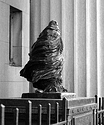RC papers have improved so much that I would not hesitate to use them. However, some galleries or collectors refuse to accept such prints.
hi gerald
that is weird that galleries and collectors refuse to accept rc paper, seeing all color ( except ink ) is
rc ( lightjet &c ) and lots and lots and lots of color prints are collected in galleries and museums ...
(
or at least were collected )
I think it's the Library of Congress (or some other important repository) that only started accepting any 35mm-digital files for submission a few short years ago (not sure, but I think the Leica M9 was one of the first), before that it was only MF digital or film.
Let people accept what they want, most of the time it's easier to find new customers than to win over hard-headed ones...
in the usa many of the states that have HABS/HAER needs accept digital files and ink prints printed on specific papers deemed to be archivally stable
( i can't really comment on the LOC because the federal HABS project still accepts film and contact prints ... )
some of the states made the switch about 5 + years ago with a big push by the federal government ... mainly because of storage of negatives and prints from what
someone told me ... they began accepting rc prints back in the early 1990s for national register ( of historic places ) applications, survey and inventory forms
and i am also guessing historic tax credit applications ( phases I-III ) around the same time, mostly because starting in the 1990s late 1980s
it was extremely expensive for a shoestring budget historic preservation consultant to pay $25 / FB print done by a lab when they could get a machine print
for something like 50¢ ( if that ) ... when i do HABS work ( which i have been doing since about 1991 ) i try to explain to my client
that even though the whole digital thing might seem cost effective submitting images on a CD and ink prints might be problematic in the years to come
seeing a CD of images isn't really very stable ( some of my cds have gone bad less than a year after being burned .. imagine the whole state's collection being corrupt soon after images were submitted .. not good ! ) so if they want ink prints i don't care, but i would rather they have a hard copy ( negatives )
as a back up ...





 15 - 20 min is enough to achieve 50 years permanency. Do you want to wash longer ? Be my guest...
15 - 20 min is enough to achieve 50 years permanency. Do you want to wash longer ? Be my guest... I do. But the history of doing that is different for me, than knowledge of chemistry at that time, when I started. Just advice of an older photographer, in the country, where commercial HCA was not available. Then.
I do. But the history of doing that is different for me, than knowledge of chemistry at that time, when I started. Just advice of an older photographer, in the country, where commercial HCA was not available. Then. 
